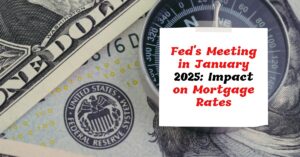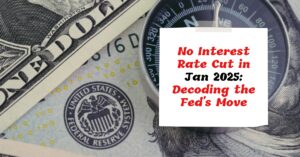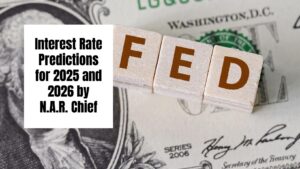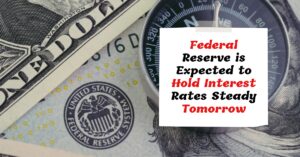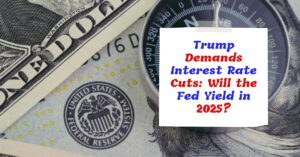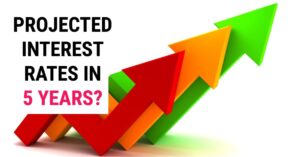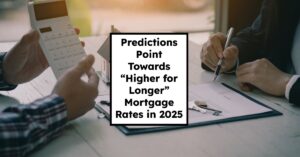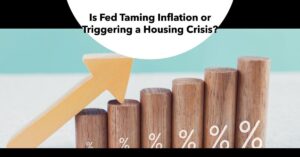The January 2025 Federal Reserve meeting had a significant impact on mortgage rates, though not in the way many might have expected. The Fed decided to hold interest rates steady, which led to a slight increase in mortgage rates due to market uncertainty about the economic outlook.
This decision, while seemingly simple, is actually a result of complex economic factors and signals a cautious approach to monetary policy. If you were watching the market at the time, it may have felt like waiting for a coin to land, unsure whether rates would go up, down, or remain the same. Let’s dive deeper into what led to this decision and what it means for you.
Fed's Meeting in January 2025: Impact on Mortgage Rates
Why This Meeting Mattered
As someone who has spent years tracking the intricacies of the financial world, I can tell you that the Federal Reserve meetings are always something to watch carefully. But this particular meeting in January 2025 had a lot riding on it. The economy at that point was like a ship navigating choppy waters. We had concerns about persistent inflation, mixed signals about economic growth, and, let’s not forget, a new administration coming into power, with a new President. These factors all put pressure on the Fed to make the right move.
Setting the Stage: Pre-January 2025 Economic Indicators
Before the January meeting, the economic situation was a mix of positives and concerns. Inflation, while not as high as in some previous periods, was still a significant worry. The Federal Reserve officials had been walking a tightrope: they wanted to control prices without choking economic growth. The December 2024 meeting revealed a cautious approach, acknowledging the uncertainties of the current situation. You could almost feel the tension in the air as everyone wondered which way they would lean. This backdrop made the January meeting all the more crucial.
The Fed's Decision: A Pause, Not a Pivot
On January 29th, 2025, the Federal Reserve finally announced its decision, and it was neither a rate cut nor a rate hike. Instead, they chose to hold steady. Fed Chair Jerome Powell, in his press conference, highlighted that the Fed was in a ‘wait-and-see' mode. It was as if they were taking a deep breath to assess the full impact of past actions and to see what the future held. This “pause” in interest rate adjustments was taken by many to mean that there is an underlying uncertainty about where the economy is headed. They were neither confident enough to cut rates aggressively, nor did they think it was appropriate to raise rates.
The Direct Link: Fed Rates and Mortgage Rates
Here’s the thing: The Fed's interest rate decisions are not just something that economists talk about. They have a real, tangible impact on our daily lives, especially when it comes to borrowing money. You see, when the Fed changes interest rates, it influences the cost of borrowing across the board.
For you and me, this is especially important when looking at mortgage rates. Generally speaking, when the Fed raises rates, mortgage rates tend to follow suit, making it more expensive to borrow money for a home. Conversely, when rates are cut, mortgage rates typically go down, making it easier to buy a house. The correlation is not always a perfect one-to-one, as other factors play a role as well, but there is definitely a strong connection.
The Immediate Impact on Mortgage Rates
Following the Fed’s January announcement, mortgage rates showed a slight increase. This was not a huge surge but more of a subtle nudge higher. This response can be attributed to market reactions. Investors and lenders interpreted the Fed’s pause as a signal that interest rates weren't going to fall anytime soon, and this uncertainty caused a bit of upward pressure on mortgage rates. If you were trying to lock in a rate around this time, you probably felt like you were caught in a game of chess, trying to predict the next move. This makes a good case for always being well informed.
Beyond the Immediate: Deeper Factors at Play
It’s also important to consider that the relationship between Fed decisions and mortgage rates isn't a simple A-to-B connection. There are so many other factors that can affect how mortgage rates behave.
- Inflation Expectations: If people expect inflation to rise, lenders will often raise rates to compensate for the loss of purchasing power of the money that they will receive in the future.
- Economic Growth: Stronger economic growth can lead to higher demand for loans, potentially pushing mortgage rates up.
- Housing Market Dynamics: Supply and demand in the housing market can also play a big role. For instance, if there are a lot of buyers competing for a limited number of homes, prices will tend to go up, and so might mortgage rates. In early 2025, the housing market was already dealing with low inventory and high demand, leading to inflated prices.
- Geopolitical Events: Unexpected events can impact the global economic climate, also affecting mortgage rates.
- Bond Market: The yield on treasury bonds often influences mortgage rates. When yields rise, so does the cost of borrowing.
These factors create a complex web of influences that shape mortgage rates. So, it’s not just about what the Fed does but how the market interprets its decisions within the context of other key economic indicators.
The Housing Market in Early 2025: A Balancing Act
By early 2025, the housing market felt like it was stuck in a unique position. On the one hand, demand was high, and many people were eager to buy. On the other hand, housing prices were elevated, and the cost of borrowing was also increasing. This created a dilemma for potential homebuyers. You may feel that no matter where you are looking, you will be either outbid or priced out.
- Low Inventory: The shortage of homes available for sale has been pushing prices up, making affordability a major challenge for many.
- High Demand: Despite higher borrowing costs, there was still a significant demand for homes, keeping prices elevated.
- Impact of the Fed’s Decision: The Fed’s decision to pause rates, although meant to be stabilizing, may actually worsen the affordability issue, as it kept borrowing costs high for longer.
The Potential Long-Term Effects
The ramifications of the Fed's January 2025 decision extend far beyond the immediate uptick in mortgage rates. We have to consider the longer-term implications for the housing market and the broader economy.
- Impact on Home Buyers: A prolonged period of steady or high rates could price many potential homebuyers out of the market, especially first-time buyers.
- Refinancing Challenges: Existing homeowners hoping to refinance their mortgages could face challenges if rates remain high or continue to rise.
- Market Stability: While the Fed’s intent was to create stability, maintaining higher rates might actually worsen the supply and demand imbalances in the housing sector.
- Economic Implications: A cooling housing market could have ripple effects on the overall economy, affecting related industries like construction, real estate, and home goods.
What This Means for You
If you're either planning to buy or refinance a home, you should pay close attention to what is happening in the market. Here's what I think are the key things you need to keep in mind:
- Stay Informed: Keep an eye on economic news and updates from the Federal Reserve and other reliable financial news sources.
- Be Prepared: Be prepared for the possibility of fluctuating rates. Do not just get carried away by FOMO.
- Consult Professionals: Talk to a mortgage broker or financial advisor who can provide personalized guidance based on your specific circumstances.
- Shop Around: Don’t just accept the first rate you're offered. Compare rates from different lenders to ensure that you are getting the best deal.
- Consider Your Options: Explore different types of mortgages and financing options to find the one that best fits your budget and needs.
- Plan Ahead: Be flexible and adjust your housing plans as necessary, depending on how the market moves.
The Need for Continued Vigilance
The January 2025 Fed meeting underscored just how interconnected the financial landscape is. The Fed’s decisions are not made in isolation, and their impacts are felt throughout the economy. As I see it, the key takeaway is that we need to remain vigilant, stay informed, and adapt to changing conditions. In this unpredictable world, having reliable information and a well thought-out strategy are essential. I believe that those who are well prepared will always fare better in the long run.
Looking Ahead
As we navigate through 2025, the housing market and mortgage rates will continue to be affected by various factors, not just Fed decisions. So, paying close attention to the economic climate is key to navigating your real estate journey successfully. I will definitely be keeping a close watch on the markets and will be here to provide more insight as things develop. Remember, being informed and adaptable is your greatest asset in this ever-changing financial landscape.
Summary
The January 2025 Fed meeting saw the Federal Reserve maintain its interest rates, leading to a slight uptick in mortgage rates, which are affected by not just Federal Reserve decisions, but also by other factors, such as inflation, economic growth, and market dynamics. Potential home buyers and current homeowners looking to refinance need to stay on top of these indicators and seek expert advice to navigate these challenges. The Fed’s decision was a result of many economic factors and signals caution about the economic recovery.
Secure Your Investments with Norada in 2025
As interest rates hold steady, explore turnkey real estate opportunities
for consistent and reliable returns.
Take advantage of favorable conditions to grow your portfolio with
ready-to-rent properties designed for success.
Speak with our expert investment counselors (No Obligation):
(800) 611-3060
Recommended Read:
- No Interest Rate Cut in Jan 2025: Decoding the Fed's Pause
- Will Interest Rates Go Down in January 2025: CME FedWatch
- Fed Cuts Interest Rates by 25 Basis Points: What It Means for You
- Fed's Powell Hints of Slow Interest Rate Cuts Amid Stubborn Inflation
- Fed Funds Rate Forecast 2025-2026: What to Expect?
- Interest Rate Predictions for 2025 and 2026 by NAR Chief
- Fed Just Made a BIG Move by Slashing Interest Rates to 4.75%-5%
- Market Reactions: How Investors Should Prepare for Interest Rate Cut
- Interest Rate Predictions for the Next 3 Years: (2024-2026)
- Interest Rate Predictions for Next 2 Years: Expert Forecast
- Impact of Interest Rate Cut on Mortgages, Car Loans, and Your Wallet
- Interest Rate Predictions for Next 10 Years: Long-Term Outlook
- When is the Next Fed Meeting on Interest Rates?
- Interest Rate Cuts: Citi vs. JP Morgan – Who is Right on Predictions?
- More Predictions Point Towards Higher for Longer Interest Rates
